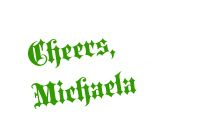 |
| Rock of Cashel |
 |
| Walking up to the Rock of Cashel. In the distance you can see the old Cistercian abbey. |
 |
| L eating her pretzel up the hill |
|
|
We walked into a small chapel called Cormac's Chapel. This was Ireland's first Romanesque church that was consecrated in 1134 by King Cormac MacCarthy. In the 12th century it just would have been this chapel and the tall round tower standing on the Rock. King Cormac is also known as St. Cormac. He is a descendant of King Aegnus and was the first bishop of Cashel.
 |
| These are frescos from 850 years ago that did not do well in Ireland's moist climate and were further damaged by the Protestants who whitewashed over them. |
 |
| This is what the chapel looks like with no one in it. I got this picture from the internet. |
|
|
In the back of the chapel is an empty sarcophagus. Nobody knows for sure whose body once lay here. They think possibly the brother of King Cormac but no one knows for sure. The front is carved in the Scandinavian style. Vikings raided Ireland and intermarried with the Irish, by the time this chapel was built.
 |
| empty sarcophagus |
 |
| Look out over the Plain of Tipperary called the "Golden Vale". The rich soil makes it Ireland's most prosperous farmland. During St. Patrick's time this was covered in oak forests. |
 |
| The graveyard still takes permanent guests but only those put on a waiting list by their ancestors in 1930. Once the rest of those people die the graveyard will be considered full. |
 |
| This is the O'Scully family crypt that once had a 20 foot elaborately carved Irish cross. It was destroyed in a lightening storm in 1976. |
The Cathedral was built between 1230 and 1290 in a Gothic style. This church used to have a wooden roof but when Oliver Cromwell's army attacked Cashel the townspeople fled to this cathedral. The army packed turf around the cathedral on the exterior and burned the cathedral down and massacring those inside.
 |
| this is one of the transepts of the cathedral |
 |
| looking at the other transcept |
 |
| Looking at the choir and nave of the cathedral |
 |
| This is looking at the Hall of Vicars Choral from the early 1400's. This housed the clerics appointed to sing during the cathedral services. |
 |
| MC and Mom C with the children |













No comments:
Post a Comment
Say hello - I'd love to hear from you!